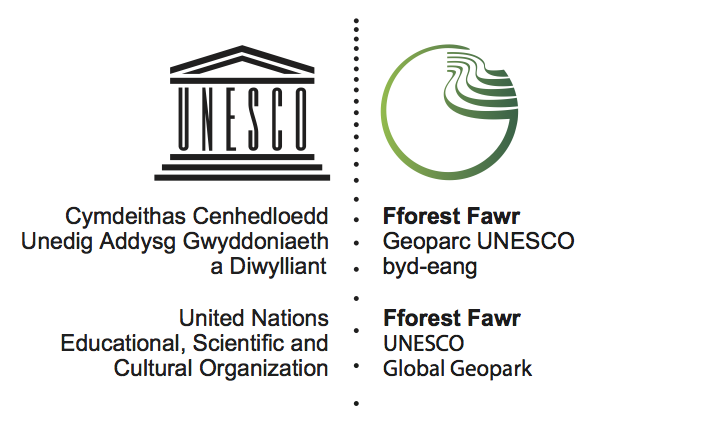One of the many uses to which the landscape of Fforest Fawr Geopark has been put is that of water-gathering. During the nineteenth century the burgeoning populations of Cardiff, Swansea and the coalfield valleys looked to the hills to their north for a convenient supply of water both for drinking and for industry.
The Geopark now boasts a dozen reservoirs ranging in size from the tiny one at Penderyn to that at Pontsticill which stores 3400 million gallons/1.5 million cu. m of fresh water. The construction of each one was shaped in some way by the local geology, local rocks being used to construct the dams and local glacial till being dug as a ‘puddling clay’ to waterproof the structures.
Each still affects the landscape in some way, some now serve modern recreational needs such as sailing or angling. Although direct access to many is not possible, they can be viewed from roads, paths or open country or even, in the case of Pontsticill from the comfort of a railway carriage.
Usk Reservoir
(OS Grid ref: SN 825290)
As its name would suggest, this reservoir which straddles the boundary between Carmarthenshire and Powys captures the headwaters of the River Usk. Swansea Corporation started construction on it in 1950 and it was opened by HM Queen Elizabeth and HRH The Duke of Edinburgh on 6 August 1955 from which time it supplied water to Swansea.
The boring of a 2370yd/2167m tunnel under Mynydd Myddfai to carry water from the reservoir to the west shed much new light on the geology of the area, providing as it did an exceptional cross-section of the geology of the mountain.
Factfile
- Capacity: 2700 million gallons/12.3 million cu. m
- Dam: 1575ft/480m long x 109ft/33m high
- Top water level is at 1006ft/307m above sea level
Llyn y Fan Fach
(OS Grid ref: SN 802218)
This picturesque lake set in a classic glacial cirque beneath Bannau Sir Gaer is perhaps 11,000 years old. It is the source of the Afon Sawdde which ultimately flows into the Afon Tywi at Llangadog, carving out the spectacular Sawdde Gorge on route. Its level was raised in the 1930’s for an improved water supply for Llanelli.
Cray Reservoir
(OS Grid ref: SN 883215)
The reservoir was built by Swansea Corporation between 1898 and 1907 impounding the headwaters of the Afon Crai for drinking water. Much of the sandstone (from the Brownstones Formation) used in the construction of the dam was sourced where the Nant Gyhirych enters the reservoir. Dressed stone (Cil-yr-ychen Limestone) came from Penwyllt Quarry.
Factfile
- Dam: 1250ft/381m long & 144ft/44m high
- Top water level is at 1001ft/305m
- Capacity: 1007 million gallons/4.6 million cu. m
- Tunnel through watershed to south
Ystradfellte Reservoir
(OS Grid ref: SN 946178)
This isolated reservoir which impounds the headwaters of the Afon Dringarth was constructed between 1907 and 1914 by Neath Rural District Council who wished to secure an improved water supply. It required the construction of seven miles of new railway from Penderyn so as to transport building materials to site. These materials included limestone from Penderyn Quarry, ‘puddle clay’ derived from the glacial till at just south of the farm at Cilhepste Coed and the sandstone of the Carboniferous age Basal Grit. This last may have been sourced from Gwaun Hepste which is now the car park used by walkers visiting the waterfalls.
There was formerly a 300ft/91m long, 50ft/15m high wooden viaduct across the Afon Hepste at SN 943108. Traces of the cuttings and embankments which enabled the temporary railway to traverse this rough country can still be seen in the local landscape.
Factfile
- Embankment: 920ft/280m long by 114ft/35m high
- Top water level is at 1204ft/367m above sea level
Penderyn Reservoir
(OS Grid ref: SN 938072)
Mountain Ash UDC started work on this storage reservoir in 1911. They got puddling clay from the fields around the minor road between Penderyn and Rhigos. Millstone Grit sandstone was quarried at SN 933079 It was completed in 1920.
Reservoirs of the Taf Fawr valley:
Three reservoirs were constructed in the valley of the Taf Fawr by Cardiff Corporation. The earliest of these was Cantref , begun in 1886 and finished 6 years later. It was followed by Beacons opened in 1897 and finally by Llwyn-onn which was completed in 1926 after 16 years in construction.
Puddle-clay for each was had from Cyfarthfa Works’ property near Six Bells PH at Pen-yr-heolgraig (though some was to come later from Neath and Pengam). Stone was quarried from Sychpant Quarry near the Taf at Cefn-coed-y-cymmer (SO 0208) although Cornish granite was used to face the weir and overflow channel steps. A railway was constructed up the valley from Merthyr Tydfil whose route can still be traced along the western side of the river in places.
Factfile
Cantref
(OS Grid ref: SN 993157)
- Top water level is at 1073ft/327m
- Capacity: 323 million gallons/1.5 million cu. m
Beacons Reservoir
(OS Grid ref: SN 986186)
- Capacity: 160 million gallons/0.75 million cu. m > 345 million/1.6 million cu. m
- Top water level is at 1340ft/408m
Llwyn-onn Reservoir
(OS Grid ref: SO 0007120)
- Capacity: 670 million gallons/3 million cu. m >1260 million/5.7 million cu. m
- Top water level is at 854ft/260m
Reservoirs of the Taf Fechan valley:
A reservoir was constructed at Pentwyn between 1859 and 1863 by the Merthyr Board of Health. Serious leakage occurred due to the dam having been constructed over the major fault zone known as the Neath Disturbance.
Partly because of the problems experienced at Pentwyn, Merthyr Tydfil Corporation constructed Lower Neuadd Reservoir in 1884. To facilitate its construction, a temporary railway line was constructed from Torpantau halt on the Brecon & Merthyr Junction railway. This route is now a bridleway followed by the Taff Trail.
Upper Neuadd Reservoir was built between 1896 and 1902 in part from limestone quarried near Dowlais brought in using the same railway. Other stone was sourced from quarries between Pant and Pontsticill down the valley. With a water level of 1506ft/459m, this reservoir is the highest in Fforest Fawr Geopark and indeed in Brecon Beacons National Park.
The much larger Taf Fechan or Pontsticill Reservoir was completed in 1927 with a carrying capacity of over 3000 million gallons/13.6 million cu. m. Puddle clay for this earth dam was gained from Pengarnddu north of Dowlais Top
Factfile
Upper Neuadd Reservoir
(OS Grid ref: SO 029191)
- Capacity: 340 million gallons/1.55 million cu. m
- Dam: 75ft/22m high
Lower Neuadd Reservoir
(OS Grid ref: SO 030182)
- Top water level at 1413ft/431m
Pentwyn Reservoir
(OS Grid ref: SO 052151)
- Capacity: 346 million gallons/1.57 million cu. m
- Also known as Dolygaer
Ponsticill Reservoir
(OS Grid ref: SO 055132)
- Capacity: 3290 million/15 million > 3400 million gallons/15.5 million cu. m
- Top water level at 1070ft/326m > 1082ft/330m water level
- Embankment: 110ft/34m high
Senni Reservoir – the one that never was!
(OS Grid ref: SN 925230)
A controversial scheme was put forward in the 1960s for a reservoir scheme which would have flooded the upper reaches of the Senni valley. The scheme was abandoned following local protests and the valley remains unaltered.
Further reading:
‘Reservoir Builders of South Wales’ (Dam Builders in the Age of Steam series book six) Bowtell H.D. & Hill G. – out of print but try a library!


